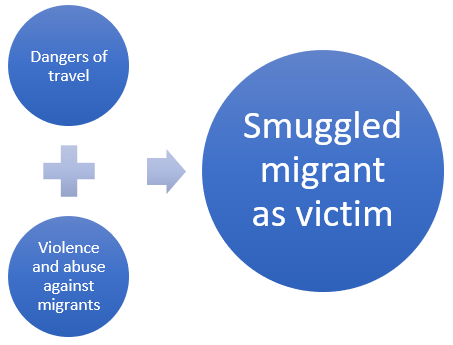UNTOC and the Protocol against the Smuggling of Migrants are criminal justice instruments. The international regulation of the crime of migrant smuggling was triggered by the need to counter organized criminal groups operating transnationally and posing serious risks to national security and public order (Gallagher, 2001). The reasons for the creation of the Protocol, in particular the concern of States over those illegally entering their territories, informs the purpose of criminalization of smuggling of migrants. Importantly, the Protocol does not cast smuggled migrants as "victims" and does not use such terminology.
This notwithstanding, the Protocol against the Smuggling of Migrants does acknowledge that smuggled migrants are deserving of protection. The provisions of articles 9 and 16 both relate to the humane treatment and protection of smuggled migrants, while article 19 preserves the application of refugee, human rights, and humanitarian law. Furthermore, the aggravated offences under article 6 recognize that penalties should increase where the safety and dignity of smuggled migrants is affected. It should be noted that, in reality, migrant smuggling has led to the death of thousands of migrants.
The Preamble of the Protocol against the Smuggling of Migrants determines the "need to provide migrants with humane treatment and full protection of their rights". Protecting the rights of smuggled migrants is a purpose of the Protocol, in addition to preventing and suppressing migrant smuggling and promoting international cooperation. Similarly, article 4 of the Protocol includes protection of the rights of persons who have been the object of smuggling within the Protocol's scope of application. Thus, the scope of the Protocol against the Smuggling of Migrants extends beyond the prevention, investigation and prosecution of SOM-related offences. As explained in the Legislative Guide for the implementation of the Protocol against the Smuggling of Migrants by Land, Sea and Air, supplementing the United Nations Convention against Transnational Organized Crime, since the "goods" being smuggled are people, migrant smuggling "rais[es] human rights and other issues not associated with other commodities" such as weapons or narcotic substances, on which the UNTOC also focuses (para. 55). The rights and protections owed to smuggled migrants are more fully set out in Module 2.
Smuggled migrants not victims - caveatDespite the concepts explained above, it is to be noted that while the Protocol against the Smuggling of Migrants does not recognize smuggled migrants as victims of smuggling of migrants, this does not equate to affirming that smuggled migrants are not victims in absolute terms. A person may be victim of other crimes, including human rights violations, during the smuggling process, for instance:
|
It is important to note that the dangers migrants are commonly exposed to--usually as a result of risky smuggling methods aimed at evading authorities and maximizing profits--may frame smuggled migrants as victims of crime in certain circumstances.

Figure 2 identifies two factors that have led to a progressive recognition of smuggled migrants as victims of crime under certain circumstances. On the one hand, the often serious dangers to the life, safety and physical integrity of migrants during smuggling ventures and, on the other hand, the violence and abuse smuggled migrants are often subjected to.